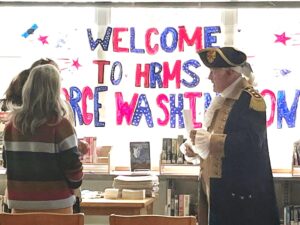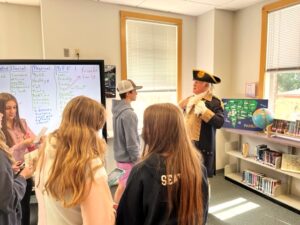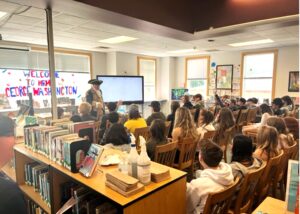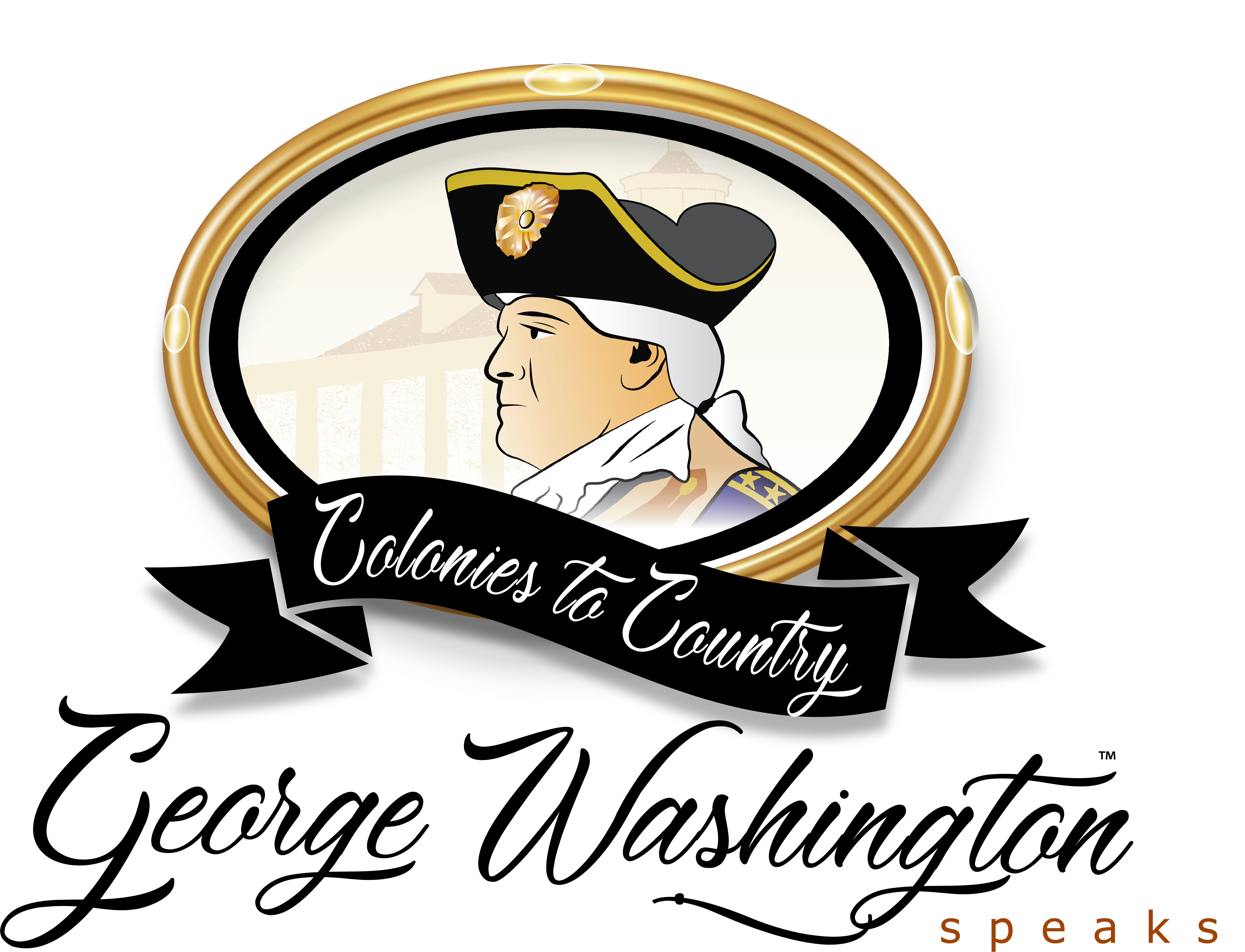
This is the fifth year that George Washington has personally appeared at Harbor Ridge, a middle school in Gig Harbor, Washington. Students prepared a welcome sign that reflects their enthusiasm to hear from the first president. They knew they could ask any questions they wanted of him. I gave five presentations (a combination of seven classes) to eighth graders as part of their American History studies. Each of the five groups had a different personality, and they put George to work with their questions. It was exhilarating!
Preparation
Before my visit, the teachers at Harbor Ridge Middle School submitted questions that their student wanted to ask George. Their primary interest was George himself. Knowing their questions in advance allowed me to craft a presentation just for them. And planning my visit in conjunction with their American History curriculum allowed the students to prepare, and consider questions for me that they might not otherwise have thought about.
In the Classroom
I began each presentation, dressed as General Washington, by asking them what they knew about me. They mentioned various facts about his family, education, social status and personality, and these were listed on a whiteboard. Then George filled in what they didn’t know about him. All of a sudden, George Washington became a real person, just like them. He had once been their age, and like any fourteen-year-old, he was awkward, shy, and fearful of being laughed at and made fun of.
Here are some of the questions we explored:
Was Washington wealthy or poor? Most thought he was wealthy and privileged, when actually, he was both.
Was he from a two-parent family? Most thought he was from a typical, two parent home, when the correct answer was “Yes and no.”
Then General Washington filled in the missing information, giving them more context about my life. In history—like many areas of life—context is everything.
Washington’s Family Life
Washington’s father married and had two sons, and then his first wife died. His father remarried, had six children with his second wife. George was the eldest of the second wife’s children, and when George was eleven, his father died. George’s father was a wealthy farmer and entrepreneur, and his sons would all have been well educated and wealthy—if their father had lived. But the bulk of wealth went to his two older half-brothers by primogeniture. Those older brothers had already been educated at a prominent school in England, something George had hoped for too. But his mother was left with a small farm, and chose not to remarry, so from age eleven, he was raised in poverty by a single mom.
This was a surprise to the students at Harbor Ridge. So you see, context is everything.

In the photo above, the young lady on the right is five feet tall, about the height of George when he was eleven, while the young man on the left is about six feet tall and about the height of George when he was fifteen. During those four years, George grew more than twelve inches, but his mother could not afford to buy him new clothes. She had to let out the clothing on the right to fit the body on the left.
George asked the student on the left: How are you feeling about wearing the smaller, older clothing?
He answered: Not good.
George gave some context with the next Question: Oh, by the way, wearing older clothes that are not in style and don’t fit, also includes the three or four socially important dances throughout the year where you meet young people from all around northern Virginia. Now how do you feel about being poorly dressed and the object of glances from those who are much better dressed?
Answer: Awkward. Embarrassed.
Question: Laughed at? Made fun of?
Answer: Silence.
Historical Interpretation
I have not found stories from Washington’s social life as a youth in anything I have read. Was the context true? Yes! His father died, he was part of the second family, a single mom raised him in poverty, his lack of education dogged him throughout his life, he was shy and awkward, and the local dances provided social opportunities. Fear of being laughed at? That detail is not recorded, but what do you think? This is part of historical interpretation.
The historical record provides a lot of information about George Washington’s life, and life in the colonies during his lifetime. My reading of more than one hundred books, visits to historical locations, and interviews with various authors, historians, and other specialists—all this informs the way I interpret and present Washington’s life.
After Class
After each presentation at the Harbor Ridge Middle School, the students came up to get selfies and ask individual questions. This young man had a couple of questions about Martha.

George accommodated him and then shared that five-foot-tall Martha would stand on her tip toes, grab his coat lapels and pull him down to get his attention, and then she would say “Now listen here old man”!
The students’ individual questions cover many topics, and reflect a strong interest in Washington and the founding of America. Likewise, the topics requested by teachers vary—some ask me to focus on the French and Indian War and Washington’s early military experience. One group wanted me to talk about agriculture and gardening at Mount Vernon, as Washington was renowned in his day for his expertise and experimentation with agriculture and animal husbandry. Learn more about George visiting students in their classrooms here https://georgewashingtonspeaks.com/for-students/
Can George Washington visit your classroom?

Most of my personal classroom visits take place in the Pacific Northwest, where I live. However, I have visited classes as far away as Nebraska, and will visit a school in Indiana in 2023 as part of a series of events there. I am always happy to visit using Zoom. If a school location requires travel, it’s always ideal if multiple presentations can be arranged on the same trip. Please email [email protected] to inquire about a visit!




